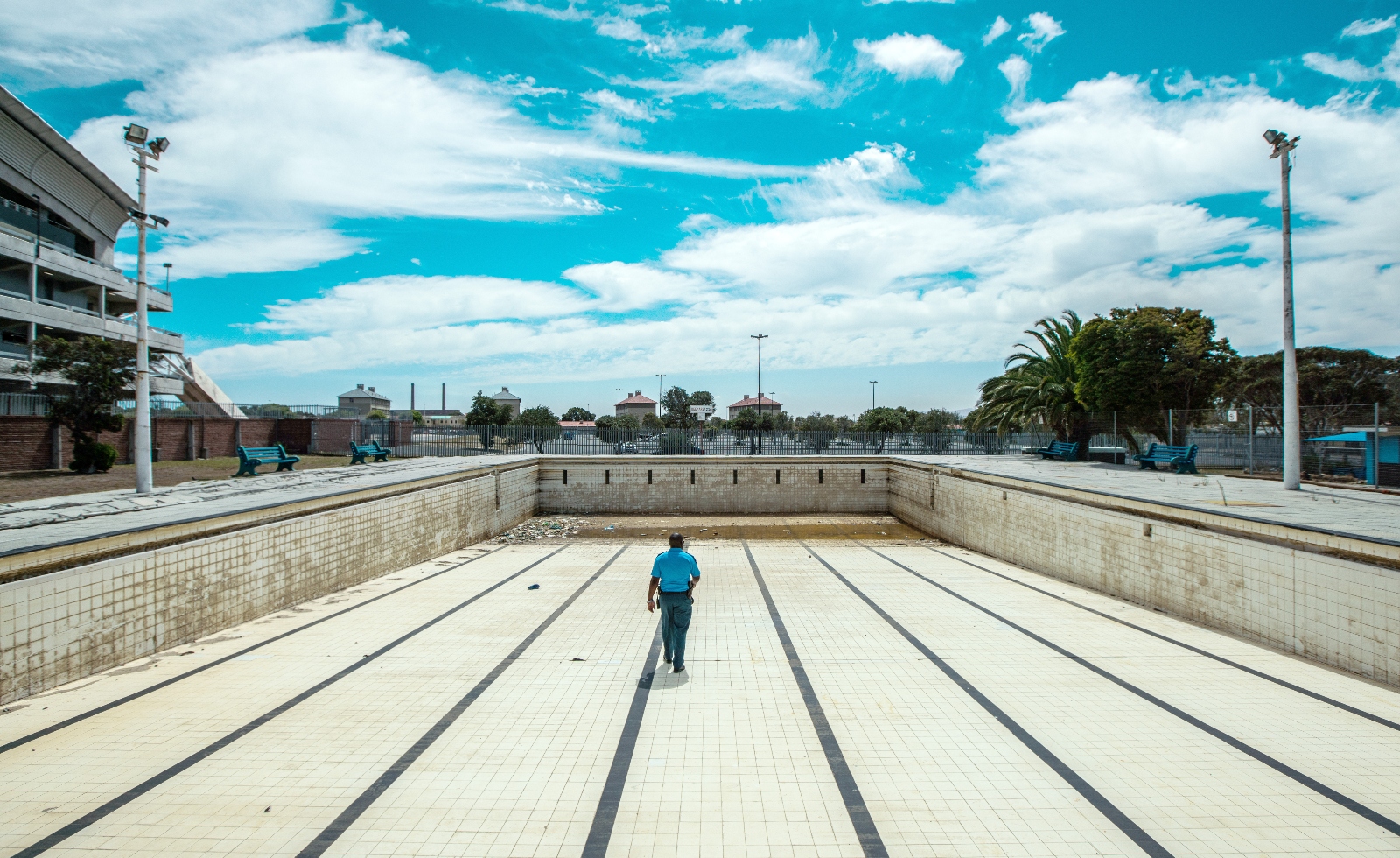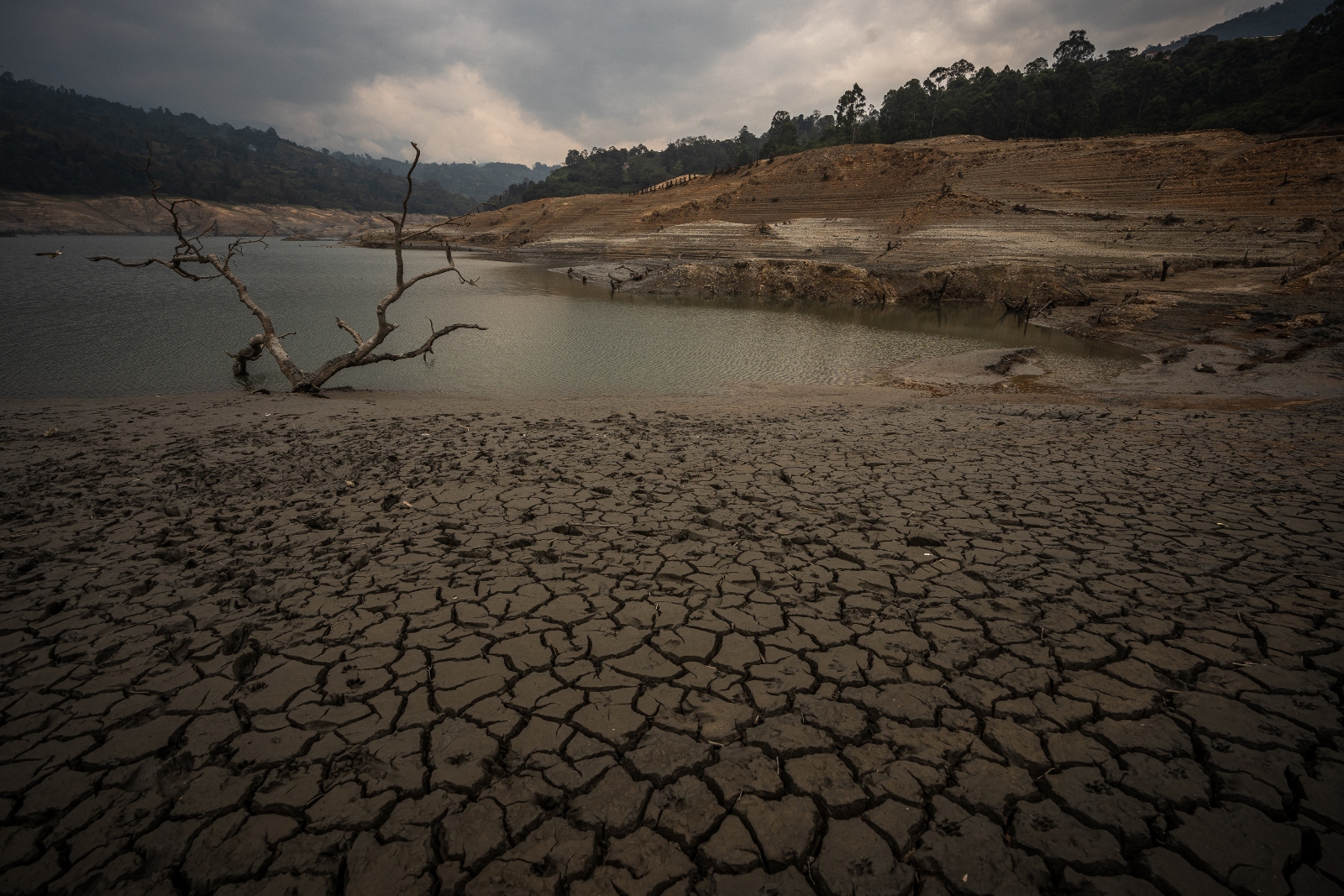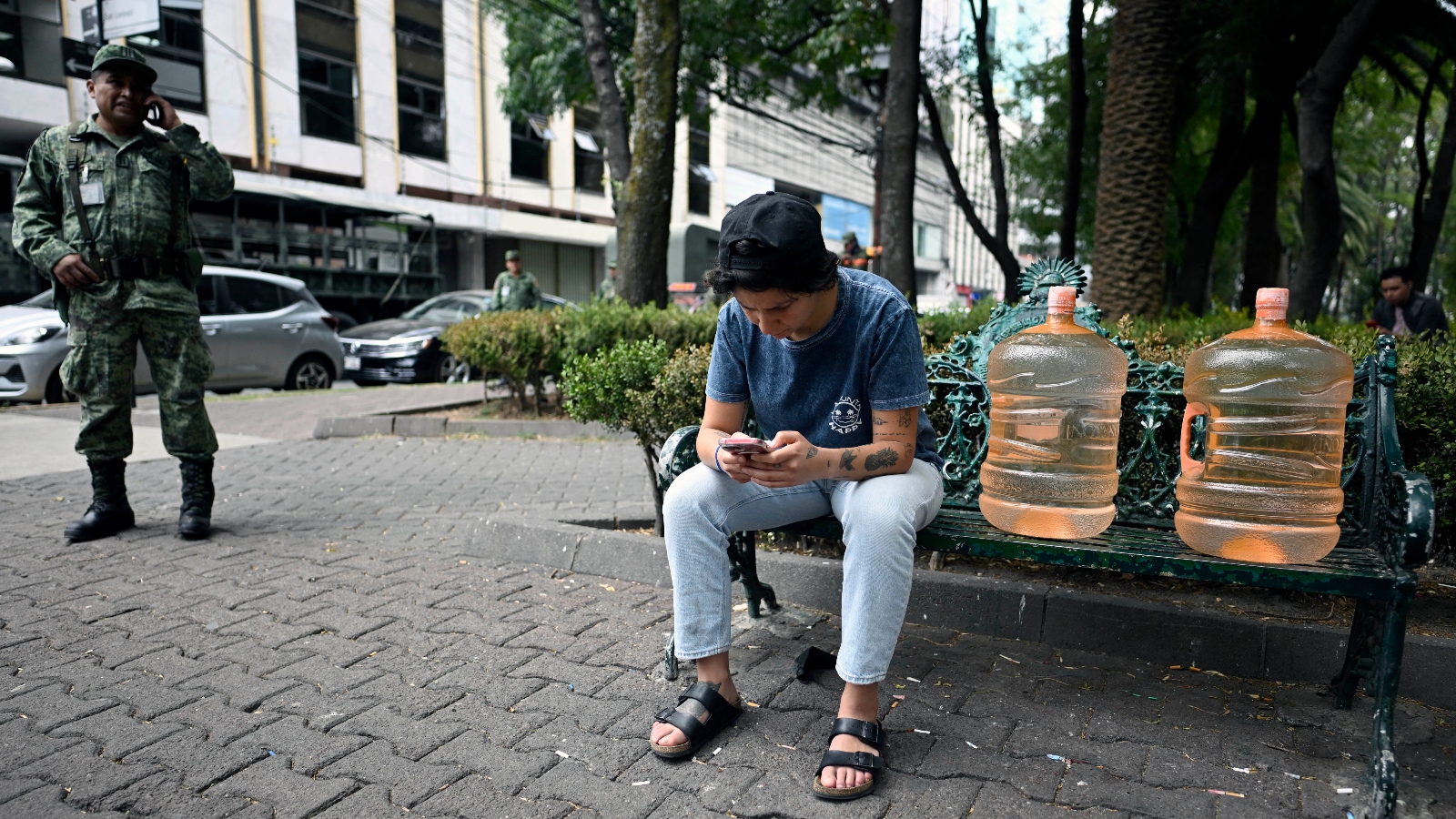In Mexico City, more and more residents are watching their taps go dry for hours a day. Even when water does flow, it often comes out dark brown and smells noxious. A former political leader is asking the public to “prioritize essential actions for survival” as the city’s key reservoirs run dry. Meanwhile, 2,000 miles south in the Colombian capital of Bogotá, reservoir levels are falling just as fast, and the city government has implemented rotating water shutoffs. The mayor has begged families to shower together and leave the city on weekends to cut down on water usage.
The measures come as a so-called heat dome sitting atop Mexico is shattering temperature records in Central America, and both Central and South America are wasting beneath a drought driven by the climate phenomenon known as El Niño, which periodically brings exceptionally dry weather to the Southern Hemisphere. Droughts in the region have grown more intense thanks to warmer winter temperatures and long-term aridification fueled by climate change. The present dry spell has shriveled river systems in Mexico and Colombia and lowered water levels in the reservoirs that supply their growing cities. Officials in both cities have warned that, in June, their water systems might reach a “Day Zero” in which they fail altogether unless residents cut usage.
In warning about the potential for a Day Zero in the water system, both cities are referencing the famous example set by Cape Town, South Africa, which made global headlines in 2018 when it almost ran out of water. The city was months away from a total collapse of its reservoir system when it mounted an unprecedented public awareness campaign and rolled out strict fees on water consumption. These measures succeeded in pulling the city back from the brink.
Six years later, Cape Town stands as a success story in municipal crisis management, but experts say its playbook will be hard for Mexico City and Bogotá to replicate. Instead of focusing primarily on changing public behavior, these cities will need to make big investments to improve aging infrastructure and shore up their water supplies. How they fare in these endeavors will in turn inform future efforts to make the world’s fast-growing cities resilient to increasing climate volatility.
“The bigger question, and what’s relevant for other cities, is now that we’ve experienced this, what can we do going forward to make sure that this doesn’t happen again?” said Johanna Brühl, a water expert at the nonprofit Environment for Development in South Africa who has studied Cape Town’s water crisis.
Coining the very phrase “Day Zero” was part of Cape Town’s solution to a water crisis that many officials had seen coming for years. As reservoir levels fell between 2015 and 2017 amid a drought, city leaders released dozens of statements urging residents to reduce water usage, but no one paid much attention. Only in early 2018, when officials started talking in increasingly apocalyptic terms about a collapse of the municipal water system, did residents — and international media outlets — start to pay attention.
The city rolled out a set of measures to enforce cuts, including a tariff system that charged more thirsty users a higher price per gallon plus a door-knocking campaign to shame the biggest water hogs. But it was the rhetoric around Day Zero that seemed to be the most effective tool to slash water usage, experts who studied the crisis told Grist. When the local government warned that residents would have to pick up buckets of water from public collection points managed by the military, consumption plummeted. The effort to stave off a water crisis began to look like a grassroots movement, with residents sharing conservation tricks like flushing the toilet with water captured from the shower.
By April 2018, water usage had fallen to about half of what it was three years earlier, a decline that astonished even city officials. As consumption dropped, the city pushed the estimated date of the apocalypse out by a few days, then a few weeks. When a big rain arrived in the early summer and began to refill the reservoirs, the government turned off the countdown altogether, declaring the crisis at a temporary end.
“The big take-home point for any city in terms of navigating that kind of crisis is just to change the culture and to get the needle moving in the right direction,” said Eddie Andrews, the deputy mayor of Cape Town, who was a city council member during the Day Zero affair. “Culture is really important — making sure that you remain on message.”
Political leaders in Mexico and Colombia have both been sending out the same dire warnings: One prominent Mexico City politician warned in March that the city is “at the edge of the precipice,” and last month Bogotá’s mayor announced that the city had only around 50 days of water remaining, with residents looking at “weeks and months” of water rationing.

But Cape Town’s grassroots conservation success will be difficult to replicate. In order for such messaging to work, residents have to trust their government. Indeed, other large South African cities like Johannesburg and Durban have struggled to spur usage reductions during periods of water stress, in part because they are governed by the African National Congress, or ANC. While the ANC has been the country’s dominant political party since its heroic 1994 victory over the apartheid regime that had ruled South Africa for decades, popular enthusiasm for the party has plummeted in recent years as corruption scandals have engulfed its top ranks. Unlike the governing bodies of South Africa’s other major cities, the Western Cape government that oversees Cape Town is led by an opposition party that enjoys far more local support than the ANC.
Manuel Perló Cohen, a professor who studies water infrastructure at the National Autonomous University of Mexico in Mexico City, said the government in Mexico City doesn’t enjoy the same kind of goodwill, meaning the government’s available tools may be limited to things like mandatory water restrictions.
“It won’t work here, because there’s a lack of confidence in the government,” he told Grist. “People don’t believe in most of what the government says, even if it’s the truth.” Mexico is just weeks away from a major election, and the incumbent leaders in Mexico City as well as the federal government have tried to downplay the water issues even as their opponents seize on it for campaign fodder.
To really have control over the future of its water, a city also needs to have control over its physical infrastructure. But Mexico City loses almost 40 percent of its municipal water to leakage from pipes and canals, one of the highest rates in the world. This means that residential conservation efforts can only have a limited effect on the overall water budget, according to Perló Cohen. The city has also seen a rise in water theft from canals and reservoir systems: Organized crime groups siphon off public water and use it to grow avocados or resell it to water-starved households at a high markup. Locals call this huachicoleo de agua, using a term coined to describe fuel theft.
While the city government of Bogotá has both the public trust and the political power to implement rotating water shutoffs — which has helped protect reservoir levels — the city’s conservation campaign is lacking another crucial ingredient: enthusiasm. As in Cape Town, residents shared novel ways to reduce water usage during the first week of the crisis, but since then the local media has stopped devoting as much attention to the shutoffs. Water usage has begun to tick back up.
“These types of campaigns are difficult to get across to people,” said Laura Bulbena, a Bogotá-based researcher with the environmental nonprofit World Resources Institute. “It’s rained a little in Bogotá, two weeks passed, and actually the numbers show that water consumption went up. So not only there isn’t enough reduction, there’s not enough water coming into the reservoirs.”
But there are other lessons from Cape Town’s water crisis, ones that any city could follow. In its aftermath, the city diversified its water system and reduced reliance on the main reservoirs that shrank during the drought. Officials now plan to build multiple seawater-desalination plants and recharge groundwater aquifers with treated wastewater. This will put the city on far better footing for future dry spells.
“Every single crisis presents opportunities,” said Andrews, the deputy mayor of Cape Town. “We’ve seen that you can’t just rely on the rainfall. You have to augment.”

Bogotá relies on reservoirs for almost its entire water supply, and officials had long believed that the reservoir system was resilient to drought. Now, they may change course and invest in alternate supplies. Experts say bringing in new water sources wouldn’t break the bank; the local water utility could tap the healthy underground aquifer beneath the city, and Bulbena’s team at World Resources Institute has shown that restoring a natural environment in the nearby Bogotá River could help clean that river’s water for drinking.
“The water system is overall very good in Bogotá, but the city must invest in a backup system, because this El Niño system will probably be repeated frequently,” said Armando Sarmiento López, a professor of ecology at Javeriana University in Bogotá.
Alejandra Lopez Rodriguez, a policy advocate at the Nature Conservancy in Mexico City, said that the government of that city could also fix its severe leakage problem and build wastewater treatment plants — if officials choose to prioritize those projects.
“We have resources and we have access to financing,” she told Grist. “There are resources available. It just also takes a will and an interest to want to invest in these issues.”
The Nature Conservancy runs a water investment fund in Mexico City that has financed conservation efforts in the pine forests surrounding the metropolis; these forests capture water and help recharge the city’s collapsing groundwater aquifers.
Recharging aquifers and building desalination plants is one thing, but the water crises in these cities have also revealed a stark fact: For many of the poorest residents in a metropolis like Cape Town, clean water was never available in the first place.
The wealthy and middle-class areas of Cape Town receive piped water from reservoirs, but residents who live in the vast townships outside the city have to get water from communal standpipes — the very fate that so frightened middle-class residents of the city in the leadup to Day Zero. In the eastern neighborhoods of Mexico City, many taps have never released water for more than a few hours each day, according to Lopez Rodriguez, and much of that water is from contaminated sections of the aquifer. Lopez Rodriguez speculates that the crisis in Mexico City has drawn international attention because it has begun to affect upper-class neighborhoods that are accustomed to reliable water deliveries from the reservoir system.
Even during the peak of the Day Zero affair, many of the worst-off residents of Cape Town pointed to the same disparity, said Richard Meissner, a professor of political science at the University of South Africa who has studied the city’s response to the 2018 drought.
“I remember that some of the less affluent people in the city said that the campaign is aimed at the more affluent portions of Cape Town,” he said. “They said, ‘They don’t care about us, because for us every day is a Day Zero.’”




